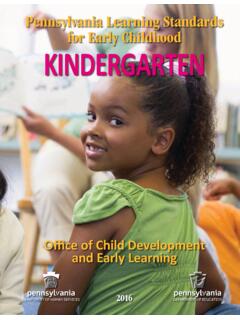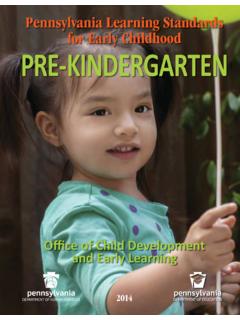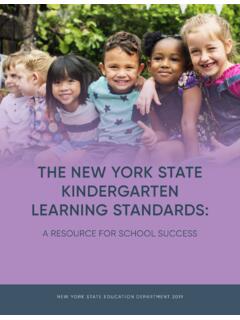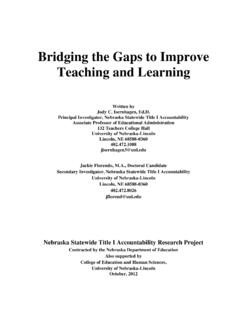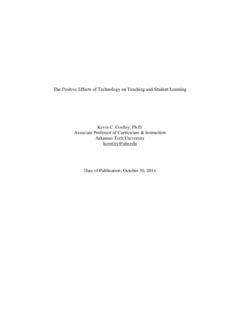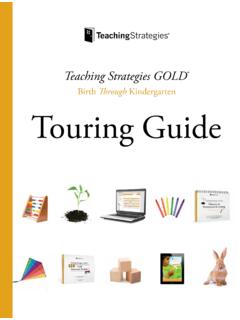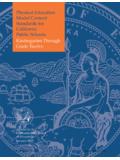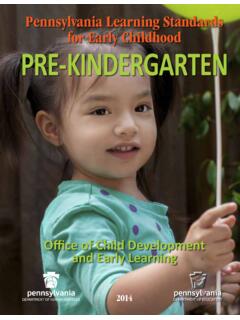Transcription of Teaching Students with Autism Spectrum Disorders - ed
1 Teaching Studentswith AutismSpectrum DisordersALBERTA learning CATALOGUING IN PUBLICATIONA lberta. Alberta learning . Special Programs Students with Autism Spectrum Disorders .(Programming for Students with special needs)ISBN 0 7785 2547 31. Autistic children Education Alberta. 2. Special education Exceptional children Alberta. 4. I. Title. Series: Programming forstudents with special needs. II. Alberta. Alberta learning . learning andTeaching Resources further information, contact:Alberta LearningAlberta LearningSpecial Programs BranchLearning and Teaching Resources Branch8thFloor, 44 Capital Boulevard8thFloor, 44 Capital Boulevard10044 108 Street10044 108 StreetEdmonton, AB T5J 5E6 Edmonton, AB T5J 5E6 Telephone: (780) 422 6326 in Edmonton orTelephone: (780) 427 2984 in Edmonton ortoll-free in Alberta by dialing 310 0000toll-free in Alberta by dialing 310 0000 Fax: (780) 422 2039 Fax: (780) 422 0576 This resource is intended for:This resource can be downloaded free-of-chargeat copies of this resource can be purchased from theLearning Resources Centre.
2 Order online or telephone 780 427 2003, the Crown in Right of Alberta, as represented by the Minister of learning , Suite 800, 44 Capital Boulevard, 10044 108 Street , Edmonton, Alberta,Canada, T5J effort has been made to provide proper acknowledgement of original sources. If cases areidentified where this has not been done, please notify Alberta learning so appropriate correctiveaction can be is given by the copyright owner for any person to reproduce this document, or any partthereof, for educational purposes and on a nonprofit basis, except for those parts for which AlbertaLearning does not hold /i Alberta learning , Alberta, Canada2003 AcknowledgementsAlberta learning gratefully acknowledges the many teachers, otherindividuals and groups who have provided advice and feedbackover the course of the development of this resource, including thefollowing: Dr. Kim Ward, Society for Treatment of Autism , principalwriter Sandra Mann, Psychologist, Calgary Board of Education All the individuals and groups who reviewed the field-test draftand provided thoughtful suggestions and comments Members of the Special Education Advisory Committeerepresenting.
3 Alberta Association for Community LivingAlberta Associations for Bright ChildrenAlberta Home and School Councils AssociationAlberta learning , Adult learning DivisionAlberta School Boards AssociationAlberta Society for the Visually ImpairedAlberta Teachers AssociationAutism Society of AlbertaCollege of Alberta School SuperintendentsCouncil for Exceptional Children (CEC), AlbertaFederationLearning Disabilities Association of AlbertaPremier s Council on the Status of Persons with DisabilitiesSigning Exact EnglishSociety for the Educational Advancement of the HearingImpairedUniversity of Alberta, Department of EducationalPsychology Alberta learning staff:Rick Hayes, Director, Special Programs BranchGina Vivone-Vernon, Director, learning and TeachingResources BranchGreg Bishop, Team LeaderTony McClellan, Education ManagerMarilyn Tungland, EditorLin Hallett, Desktop PublisherDianne Moyer, Desktop PublisherSandra Mukai, Copyright Officerii/ Teaching Students with Autism Spectrum Disorders2003 Alberta learning , Alberta, CanadaAlberta learning gratefully acknowledges the British ColumbiaMinistry of Education and Saskatchewan Education for providingthe text of the document, Teaching Students with Autism : A Guidefor Educatorsas a starting point for this to the Series /iii Alberta learning , Alberta, Canada2003 Introduction to the SeriesThe following books are included in theProgramming forStudents with Special Needsseries.
4 The information in eachbook is interrelated and can be used to provide instruction to 1: Teaching for Student Differences(1995)Book 1 highlights strategies for differentiating instruction withinthe regular classroom for Students who may be experiencinglearning or behavioural difficulties, or who may be gifted andtalented. It includes ideas for varying instructional time, thelearning environment, resources, materials, presentation,assignments and assessments to accommodate Students withdiverse needs. This book contains instructional strategiesarranged by core subjects as well as by categories of differences, , learning disabilities, behaviour Disorders , and gifted andtalented. The appendices contain a variety of useful forms forteacher 2: Essential and Supportive Skills forStudents with Developmental Disabilities(1995)Book 2 includes: developmental checklists for communication skills, ,receptive, expressive, social, articulation and vocabulary checklists for gross and fine motor development, includingcolouring, graphics, manuscript printing and cutting charts and checklists which provide a continuum of life skillsby domain checklists for mathematics, reading and writing to Grade 6 an annotated list of Teaching 3: Individualized Program Plans(1995)Book 3 contains a process for IPP development and strategiesfor involving parents.
5 This book provides information onwriting long-term goals and short-term objectives along withcase studies and samples of completed IPPs. It addressestransition planning, and features forms and checklists to assist Students with Autism Spectrum Disorders2003 Alberta learning , Alberta, CanadaBook 4: Teaching Students who are Deafor Hard of Hearing (1995)Book 4 includes information on the nature of hearing loss andvarious communication systems. The book contains informationon amplification, educational technologies, program planningand Teaching 5: Teaching Students with VisualImpairments (1996)Book 5 offers basic information to help provide successfulschool experiences for Students who are blind or visuallyimpaired. The information in this book addresses: the nature of visual impairment educational implications specific needs instructional strategies the importance of orientation and mobility instruction the use of 6: Teaching Students with LearningDisabilities (1996)Book 6 provides practical strategies for regular classroom andspecial education teachers.
6 Section I discusses the conceptualmodel and applications of the domain model. Section II includesidentification and program planning, addressing earlyidentification, assessment, learning styles and long-rangeplanning. Section III contains practical strategies within specificdomains, including metacognitive, information processing,communication, academic and social/adaptive. Section IVaddresses other learning difficulties including attention-deficit/hyperactivity disorder and fetal alcoholsyndrome/possible prenatal alcohol-related effects. Theappendices contain lists of annotated resources, test inventories,support network contacts and blackline 7: Teaching Students who are Giftedand Talented (2000)Book 7 provides practical strategies for regular classroom andspecial education teachers. Section I addresses administration ofprograms for the gifted and talented at both the district andschool levels. Section II discusses conceptions of giftedness,highlighting nine theoretical models.
7 Section III discussesidentification of gifted and talented Students , includinginformation on gathering and recording data using severalIntroduction to the Series /v Alberta learning , Alberta, Canada2003information on gathering and recording data using severaldifferent measures, developing individualized program plans,communicating with and involving parents. Section IVdiscusses giftedness in the visual and performing arts. Section Vcontains strategies for designing and implementing programs,including curriculum modification. Section VI discusses postmodernism and gifted education. The appendices contain lists ofannotated resources, test inventories, support network contactsand blackline 8: Teaching Students with EmotionalDisorders and/or Mental Illnesses (2000)Book 8 takes a comprehensive look at six emotional Disorders ormental illnesses: eating Disorders , anxiety Disorders , depression,schizophrenia, oppositional defiant disorder and conductdisorder.
8 It describes the characteristics, symptoms and riskfactors that may trigger the onset of the disorder or illness, andpresents strategies for teachers, parents and other caregivers touse to assist :Children and StudentsIn Alberta, theSchool Actdraws a distinction between childrenand Students . In general, the term student refers to anindividual who at September 1 in a year is 6 years of age orolder and younger than 19 years of age. A child refers to anindividual who is younger than 6 as of September 1 of the yearthe child enters an educational program. In Alberta, childrenwith severe disabilities may be eligible for special educationprogramming at 2 years at September information, approaches andstrategiesincludedinthisresource have wide applicability and are generally appropriatefor both children and Students . For the sake of readability, theterm student will be used throughout this resource to refer toboth children and Students who are eligible for special Students with Autism Spectrum Disorders2003 Alberta learning , Alberta, CanadaTable of Contents /vii Alberta learning , Alberta, Canada2003 Table of ContentsPageChapter 1: What are Autism Spectrum Disorders ?
9 1 Prevalence ..2 Causes ..2 Diagnoses ..3 Other Pervasive Developmental Disorders ..5 Autism Spectrum Disorders : Myths ..7 Chapter 2: Characteristics Associatedwith Autism Spectrum Disorders ..9 Communication ..9 Social Interaction ..11 Unusual/Challenging Behaviours .. 13 learning .. 14 Unusual Patterns of Attention .. 15 Unusual Responses to Sensory Stimuli .. 16 Anxiety .. 18 Final Thoughts on Characteristics .. 19 Chapter 3: Collaborating with Parents .. 21 The Experiences of Families .. 21 Collaborating with Parents .. 24 Chapter 4: Planning Support for Students with Autism Spectrum Disorders .. 31 Developing Individualized Program Plans (IPPs) .. 31 Strategies to Facilitate Effective IPPs .. 34 Integrated Case Management .. 36 Chapter 5: Classroom Instruction .. 39 General Instructional Approaches .. 39 Effective Teaching Practices .. 48 Strategies for Addressing Sensory Issues.
10 54 Strategies to Facilitate Communication .. 60 Strategies for Teaching Social Skills .. 69 Teaching Functional Skills .. 78 Chapter 6: Managing Challenging Behaviour .. 83 Positive Behavioural Supports .. 83 Chapter 7: Facilitating Inclusion .. 111 Teacher Preparation .. 111 Preparing Students with Autism Spectrum Disorders .. 112 Promoting Understanding .. 113 Adapting Instruction .. 114 One-to-One Instruction .. 120 Promoting Positive Peer Interactions .. 121viii/ Teaching Students with Autism Spectrum Disorders2003 Alberta learning , Alberta, CanadaChapter 8: Transition Planning .. 125 Transition into the School System .. 125 Transitions Between Activities and Settings .. 126 Transitions Between Grade Levels .. 127 Transitions Between Schools .. 128 Transition from High School to Adult Life .. 130 Chapter 9: Students with Asperger s Syndrome .. 133 learning and Behavioural Characteristics .. 133 Strategies.











